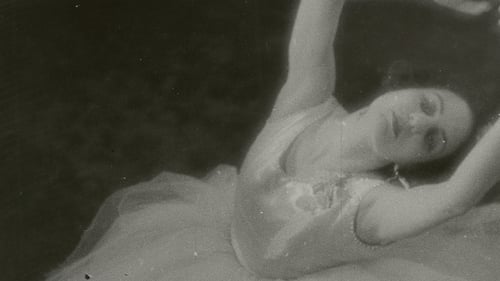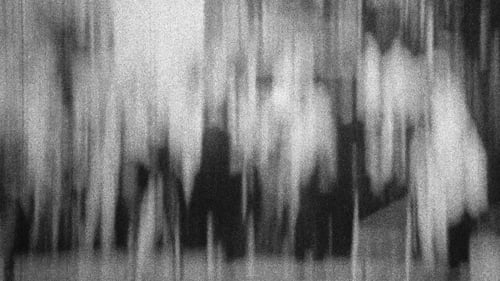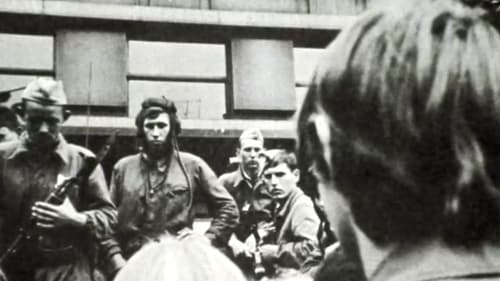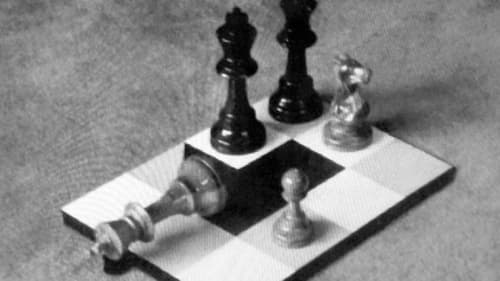Tree Trunk to Head (1938)
Género : Documental
Tiempo de ejecución : 35M
Director : Lewis Jacobs
Sinopsis
“The personality of the sculptor Chaim Gross, his mannerisms, his characteristic method of work, his tendencies are all intimately disclosed in minute details, as though unobserved—a sort of candid-camera study. Dramatic form and cinematic structure endow the presentation with excitement, humor, and interest.” —Lewis Jacobs

An early experiment in employing computers to animate film. The result is a dazzling vibration of geometric forms in vivid color, an effect achieved by varying the speed at which alternate colors change, so producing optical illusions. In between these screen pyrotechnics appears a simple line form gyrating in smooth rhythm. Sound effects are created by registering sound shapes directly on the soundtrack of the film.

Although Rahsaan Roland Kirk and John Cage never actually meet in this film (Cage's enigmatic questions about sound are intercut with some of Kirk's more ambitious experiments with it) these two very different musical iconoclasts share a similar vision of the boundless possibilities of music.

Eureka (1974), which lyrically re-photographs a travelogue shot from a San Francisco streetcar, offers the purest expression of Gehr’s deep love of early cinema as a source of a joyous formal inventiveness-- changing its length from 5 to about 38 minutes.

"My first film, THE PATH, was based on a dream about a group of people on an ‘outing’ or a picnic. The people in the dream meet and greet one another and then walk around and through old houses, barns, and buildings. Inside these structures they pass by other people involved in various activities. A woman is folding clothes. A man is making paintings. A young girl is sitting in front of a mirror trying on different necklaces." - Richard Myers

I evoke a dancing woman. A woman? No. A bouncing line with harmonious rhythm. I evoke a luminous projection on veils ! Precise matter! No. Fluid rhythms. Why should one disregard, on screen, the pleasure that movement brings us in the theatre? Harmony of lines. Harmony of light. Lines, surfaces, volumes evolving directly, without the artifice of evocation, in the logic of its forms, dispossessed of any overly human sense, allowing an elevation towards the abstract, thus giving more space to sensations and to dreams : integral cinema. —Germaine Dulac

A documentary portrait shot in Positano, Italy in 1965 about Australian artist and occultist Vali Myers.

This story is built up with filmed documents in an experimental fashion.

This film tells the story of Gonthramm, a young knight who sought in vain for the Holy Grail and, on the way back to join his bride, Galeswithe, is met by Queen Banschi in the nightmarish realm of the Sylphs. Brum do Canto based the story on Charles-Marie Leconte de Lisle's Les Elfes.

An experimental feature made by rephotographing the 1905 Biograph short Tom, Tom, the Piper's Son.

Filmed clandestinely in Czechoslovakia on 16mm. It's one of the films Godard made with the Groupe Dziga Vertov - a Marxist film about the political situation after the '68 revolution.

A poetic ode to the River Seine, Ivens' distinguished camera eye surveys its lively banks and step-stone canals with a vérité candor, a beguiling elan.

Short film of 7 sections with each one using a different experimental film technique.

A commentary on the destructive expectations of females in a male dominated society, Marilyn Times Five was made from an old stag film called "The Apple-Knockers, and the Coke"(1948) these sections of the film were set to Marilyn Monroe's song "I'm Through With Love". The film depicts a Marilyn Monroe look-a-like slowly taking her clothes off for the camera (the viewer). The woman's actions are looped several times which gives the audience a sensation of exhaustion. That exhaustion keeps building until the very end where the woman is shown crumpled on the floor in an awkward position, which makes it appear as if she is lifeless.

A darkish journey down memory lane, to visit some news events, folkways and thought patterns associated with the late forties and early fifties. The film is also concerned with such perceptual phenomena as color-space, "false tones" caused by varying black-white alternations of simultaneously seen rhythms set up by multiple repetitive actions, and the use of image outlines as "containers" for other imagery. Sort of a working notebook, which is continued in EASYOUT and DOWN WIND.

This short film made by László Moholy-Nagy is based on the shadow patterns created by his Light-Space Modulator, an early kinetic sculpture consisting of a variety of curved objects in a carefully choreographed cycle of movements. Created in 1930, the film was originally planned as the sixth and final part of a much longer work depicting the new space-time.

“Superimposed photographs of Mr. Fleischman’s butcher shop in New York, and the Kiowa around Anadarko, Oklahoma–with Cognate Material. The strip is dark at the beginning and end, light in the middle, and is structured 122333221. I honor it the most of my films, otherwise a not very popular one before 1972. If the exciter lamp blows, play Bert Brecht’s Mahogany.”– Harry Smith

"A film portrait cut to the tune of Conway Twitty's version of 'Mona Lisa.' Filmed in part at a 1964 show of Conner's artwork in San Francisco, the film is also a witty statement about forces that take the life out of art. Vivian Kurz, the subject of the film, is entombed in a glass display case." - Judd Chesler Award: Gold Medal Award, Sesta Biennale D'Arte Republica Di San Marino. Da Vinci thought he caught her smiling.

8 x 8: A Chess-Sonata in 8 Movements is an American experimental film directed by Hans Richter, Marcel Duchamp, and Jean Cocteau. Described by Richter as "part Freud, part Lewis Carroll" and filmed partially on the lawn of Duchamp's summer house in Southbury, Connecticut.

Segunda adaptación conocida del clásico relato de Edgar Allan Poe, tras la realizada por D. W. Griffith en 1914. Un hombre sufre el peso de la culpa del asesinato que ha cometido.

An avant-garde montage of a boxing match, based on a poem by Paul Werrie.







